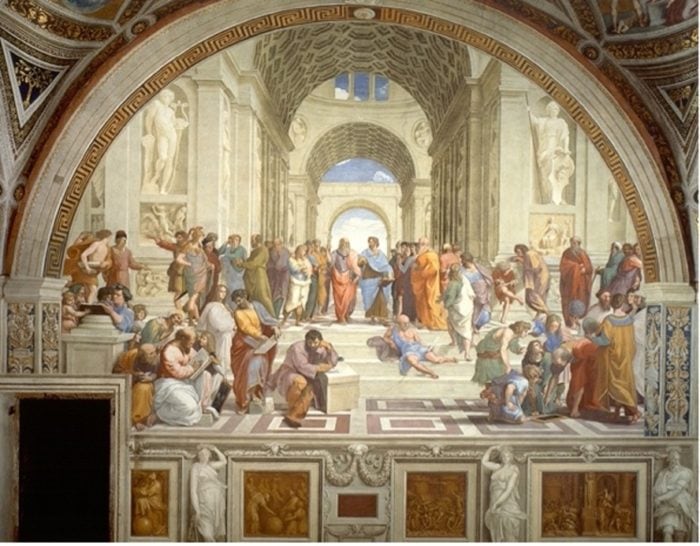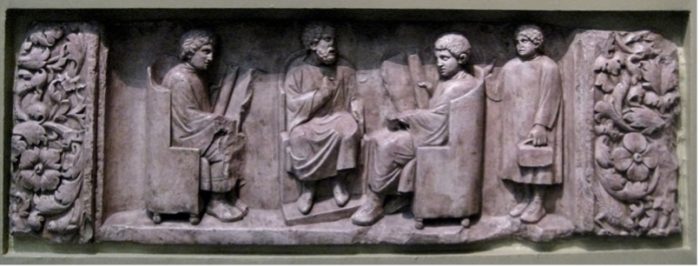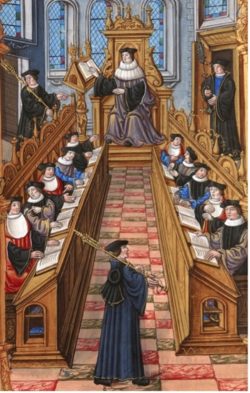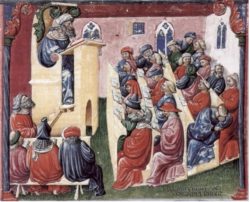Synopsis
Humanity is a teaching species and, consequently, there may have been as many distinct enactments of education as there have been definable cultures. For our purposes on this page, we are most interested in the immediate precursors to the public schooling, including the ancient Greek academy, the medieval university, and the early parochial school. These institutions were united in their emphasis on order and their commitment to Truth. For the most part, order and Truth were framed in opposition to (or as remedies for) popular beliefs about the natural, which was understood anarchical and tending toward corruption. In terms of defining metaphor, education came to be overwhelmingly about clear direction and the “straight and narrow,” avoiding deviations and deflections (i.e., anything off the line). Relevant constructs and instantiations include:- Academy (Platonic Academy) (Plato, commencing 300s BCE) – embodying the original meaning of “school” (from the Greek skhole “spare time, leisure”), the Academy was among the first locations dedicated to learned discussion and philosphical debate – as epitomized in Raphael’s “The School at Athens”)

The School of Athens (Raphael, 1500s, Public Domain)
- Roman Municipal School (commencing first centuries CE) – formal schools with paying students, structured in a manner highly reminiscent of today’s primary–secondary–post-secondary sequence – although placement was based more on innate ability (see Nativism) than age.

Relief of a teacher with three students (discipuli) (~180 CE, Public Domain)
- Cathedral School (commencing ~500s CE) – established by religious leaders to provide the Church with an educated clergy, boy choir members, literate administrators, and an educated nobility.
- Monastic School (commencing ~800 CE) – complementing Cathedral Schools, and regarded as the most important sites of formal education for several centuries, Monastic Schools addressed both religious and secular topics, with the latter defined in large part according to emergent disciplinary domains within the Trivium and Quadrivium:
- Trivium – grammar (the mechanics of language), logic (the strategies of thought), rhetoric (the art of persuasion)
- Quadrivium – arithmetic (number in the abstract), geometry (number in space), music (number in time), astronomy (number in space and time)
- Medieval University (commencing ~1100 CE) – a progenitor of the modern university that was initially defined in part by its embrace of Scholasticism and its focus on Neoplatonism and its commitment to ideals of order and discipline. Discourses associated with the Medieval University include:
- Neoplatonism (~200 CE) – a modern term to refer to a reputed shift in how Plato's (~424–348 BCE) philosophy was interpreted, usually attributed to Plotinus (~205–270 CE) and his successors. Most commonly, Neoplatonism is described as three key tenets: (a) a dichotomization of spirit and flesh, (b) a suspicion of sensory perception, and (c) the embrace of an ascetic lifestyle as a means to transcend one’s base existence. Neoplatonism is regarded as one of the major influences of both mystical and religious belief systems in the modern Western world. Though the term is widely used, its usefulness and appropriateness are disputed.
- Scholasticism (commencing ~1100 CE) – a model of learning and teaching that emphasizes reason, dispute, and debate in its efforts to blend Neoplatonism and Christian belief
- Liberal Education (Liberal Arts Education) (commencing ~1300s CE) – a medieval concept associated with the definition of the Liberal Arts (see below). The phrase has since evolved to refer to a broad and varied education with strong emphases on ethics and engagement. Associated discourses include:
- Liberal Arts – a phrase coined in the 1300s (from Old French liberal “befitting free people”) to refer to the appropriate education of a gentleman. The Liberal Arts were initially defined in terms of the Trivium and Quadrivium (see above) – but, as might be inferred from the derivation of the word “trivia” from “Trivium,” the notion has since devolved.
- Classical Education Movement (1990s) – a modern movement involving a loose-knit group of organizations that offer some version on a traditional Liberal Arts Education
 Meeting of doctors at the University of Paris
(1500s, Public Domain)
Meeting of doctors at the University of Paris
(1500s, Public Domain) |
 A university class in Bologna
(1300s, Public Domain)
A university class in Bologna
(1300s, Public Domain) |
- Parochial Schools (Parish Schools) (commencing ~1400s) – emerging in the pre-Industrial era, often in ad hoc and piecemeal manners, and initially with little or no imposed expectations, Parochial Schoolswere typically organized to address emerging local needs for literacy and other formal competencies. Contemporary synonyms of “parochial” such as “insular,” “petty,” and “small-minded” might be taken as evidence that there were issues with Parochial Schools.
Context
In the first millennium BCE, across southern Asia, northern Africa, and southern Europe, there was a trans-societal turn – away from pervasive tribalism and warfare toward an ethos of diplomacy and wisdom. Two especially prominent trends emerged. In India, China, and other parts of eastern Eurasia (led by thinkers such as Confucius, Mencius, Buddha, and Lao-Tzu), these trends were oriented toward better understanding the complex unity of being:- Buddhism (Dharmavinaya; Buddha Dharma) (Siddhartha Gautama, c. 500 BCE) – from the Sanskrit for “awakened one,” Buddhism holds that one should strive for a transformation of consciousness so as not to be mastered by wants, needs, and desires. Buddhist enlightenment is associated with an “eightfold path,” which includes right speech, right action, right livelihood, right effort, right mindfulness, right concentration, right views, and right intentions. Associated perspectives include:
- Zen Buddhism (c. 400 BCE) – a version of Buddhism in which the quest for enlightenment is through direct, intuitive experience (mediated, e.g., by motionless meditation or contemplation of insoluble paradoxes) intended to make one aware of the limitations of language and to help one transcend rational, instrumental thought
- Confucianism – a diversely interpreted term that is applied to practices and ways of living that are aligned with principles associated with or attributed to Confucius (i.e., Master Kong, ~500 BCE). Specific to matters of learning, Confucianism foregrounds relationships among action, experience, reflection, and knowledge/knowing. Learning and acting on what one has learned entails critical deliberation, virtuous intention, and openness to the endlessly elaborative process of knowledgeable action.
- Premodern Era – in the western world, the period of history that ended with the Scientific and Industrial Revolutions – or, more concisely stated, the period prior to the Modern Era (see below)
- Modernism (Modern Era; Modernity) – roughly, since the 1600s, marked by changes in conceptions of and attitudes toward knowledge wrought by the Scientific Revolution, and subsequent shifts in one’s mode of engaging with the world brought on by the Industrial and Capitalist Revolutions – all of which presented the need for a new a distinct type of public school (see Standardized Education). Many descriptors – sometimes conflicting – have been applied to the era, with the most common ones tending to focus on emergent dichotomies such as human-from-world, individual-from-collective, and fact-from-fiction.
Paradigm
 Paradigmatically – that is. in terms of a fitting model or symbol – we offer that a line segment might be used to signal some of the era’s defining sensibilities. For us, this visual metaphor calls to mind notions of …
Paradigmatically – that is. in terms of a fitting model or symbol – we offer that a line segment might be used to signal some of the era’s defining sensibilities. For us, this visual metaphor calls to mind notions of …
- linearity – the pervasiveness of which is evident in words derived from roots that had to do with “straightness” – e.g., right, rect- (as in correct & rectify), rule, regular, just, and true
- directness – manifest in rational arguments, simple cause–effect dynamics, in popular start-to-finish storylines, and in assumptions of pregiven ranks, orders, categories, and classes
- divisions – including the separations: mind/body, self/other, individual/collective, human/natural, as well as distinctions among disciplines and levels of achievement/performance
.
Prominent Metaphors of Learning
- Attainment Metaphor (i.e., following a path to a goal; the English learn is derived from the Proto-Indo-European lois-, “furrow” or “track”)
- Changing (in general, toward the more complex)
- Developing (of abilities; of self)
Prominent Metaphors of Knowledge
- Light (Illumination Metaphor)
- Ideal (the Eternal, the Transcendent)
- Domain (Field, Territory, Area)
Prominent Metaphors of Teaching
- Pointing (“Teach” is derived from Old English tǣcan, “point out” or “show.”)
- Enlightening
- Stewarding
- Disciplining
Subdiscourses:
- Academy (Platonic Academy)
- Buddhism (Dharmavinaya; Buddha Dharma)
- Cathedral School
- Classical Education Movement
- Confucianism
- Liberal Arts
- Liberal Education (Liberal Arts Education)
- Medieval University
- Modernism (Modern Era; Modernity)
- Monastic School
- Neoplatonism
- Parochial Schools (Parish Schools)
- Premodern Era
- Roman Municipal School
- Scholasticism
- Zen Buddhism
Please cite this article as:
Davis, B., & Francis, K. (2023). “Premodern Formal Education” in Discourses on Learning in Education. https://learningdiscourses.com.
⇦ Back to Map
⇦ Back to List
